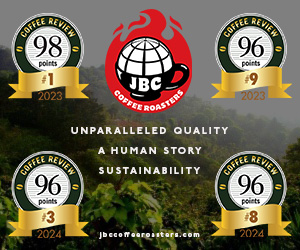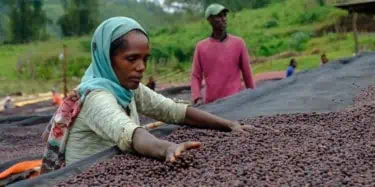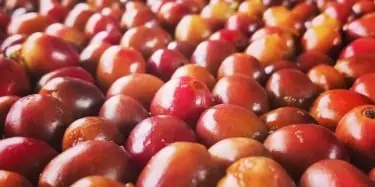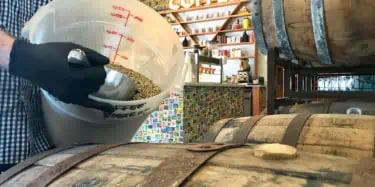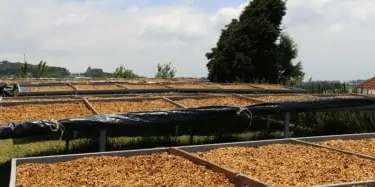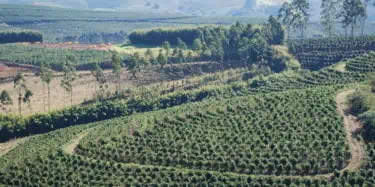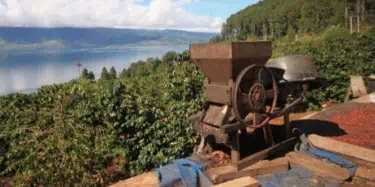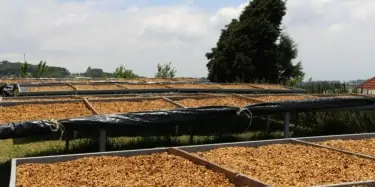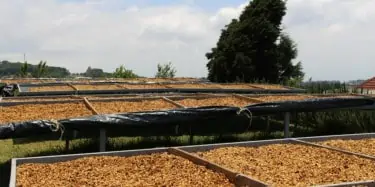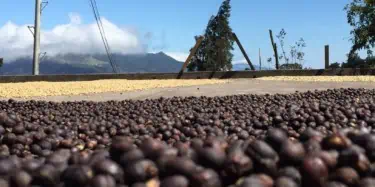At the experimental tip of the specialty coffee world, the excitement never stops. The latest processing twist from Colombian and Central American coffee growers involves putting natural fruit, herbs or spices into the fermentation tank with the coffee during processing. The fermentation tanks are usually sealed, making this fermentation anaerobic as well. Readers of our March 2023 report know
Tasting Reports - Processing Method
Coffee Review has published more than 250 monthly coffee tasting reports since February 1997. The tasting reports below, featuring coffees produced by a specific processing method, appear in reverse chronological order. You may refine your search by using the key word search feature that appears in the page header. The content in tasting reports and associated reviews was correct at the time of publication but may not remain accurate over time.
Fresh Fruit or “Juicy Fruit”? Tasting 90 Anaerobic-Processed Coffees
Of all of the innovations challenging traditional expectations in specialty coffee today, the use of anaerobic (limited oxygen) fermentation to alter and intensify the character of the cup is perhaps the most striking. Anaerobic-fermented coffees that explicitly and successfully express this method tend to be intense and almost shockingly floral and fruit-toned, with the flowers often
Fun With Ferment: Anaerobically Processed Coffees
In early April, some rather odd-smelling packages began arriving at the Coffee Review lab. Describing the collective aromas that wafted from them is difficult. And describing those aromas continued to be difficult once we started actually tasting the coffees inside the packages. Certainly, there was lots of fruit and chocolate. And fragrant cut cedar, and sweet flowers. But along with these more
The Fate of a Classic: Washed Central America Coffees
For decades, the classic washed or wet-processed coffees of Central America and Mexico have constituted one of the world’s great go-to coffee types. Usually clean-tasting, usually sweetly-tart, with a shifting array of fruit notes – always stone fruit, typically some citrus and flowers, always notes ranging from nut and caramel to full-on dark chocolate depending on the coffee and roast. And most
Anaerobic Fermentation and Other Palate-Bending Processing Experiments
I recall that, in high school, teachers graded essays based on various conventional writing categories — grammar and diction, clarity, organization, etc. But most also gave credit for originality. Often, some friend’s paper would show weaknesses in regard to comma placement, word choice, and clear organization but attract a high grade for originality. Perhaps you could say that some of the
Hawai’i: A New Wave of Coffee Innovation
The Hawaiian Islands are known the world over for beautiful beaches, diverse microclimates, and both active and dormant volcanoes — pretty much paradise, as the cliché goes. Hawaiian culture is both uniquely American and, in many ways, happily incongruous with mainstream American culture. One island in particular, Hawai'i Island (often called the Big Island), produces the famous, widely
Natural-Process Espressos: Fruit and Chocolate Exalted
I recently led a tasting of fine coffees at a consumer event. Only one of these coffees was natural-processed, i.e., had been prepared at the mill by drying the coffee seeds or beans inside the whole fruit. The other samples were all washed coffees, processed by drying the beans after the fruit skin and flesh had been removed. The washed method is the traditional norm for fine coffee in most
Aged, Casked and Cured: Innovations in Green Coffee Conditioning
Green, unroasted coffee beans are porous and absorbent. As anyone in the industry knows from painful experience, green beans easily pick up odors from almost anything in their environment — paints stenciled on coffee bags, for example, concrete floors, petroleum residue in shipping containers, cardamom stored in the same warehouse. But where there is a problem there also may be an opportunity.
Honey-Processed Coffees: Quiet Adventure
Honey coffee, honey-processing – what wonderful coffee language! It’s a language that sells (after all, most of us like honey), but it sells honestly. I can’t think of a better descriptor than “honey” for a process in which coffee beans are dried with the sticky-sweet, golden layer of fruit flesh still clinging to them, rather dried after the fruit flesh has been completely removed as it is in the
Brazil Naturals: Tradition Meets Trend
Although Coffee Review has published a number of articles over the years focusing on coffees from Brazil, we have never specifically focused on the coffee type generally called “Brazil naturals”: Brazil coffees of the Arabica species that have been dried inside the fruit rather than after the fruit has been removed (as is the case with conventional “washed” or wet-processed coffees). Brazil
Elegant Earth: Wet-Hulled Sumatras and One Sulawesi
Wet-hulling is not an obscure Olympics sailing event nor (at least to my knowledge) a special trick in waterskiing or wakeboarding. It is a fruit removal and drying variation that contributes much of the distinct character of traditional Indonesia coffees, particularly those from Sumatra and Sulawesi. It is also practiced on other Indonesian islands, almost everywhere in Indonesia where small
Honey and Natural Process Coffees, Central America 2014
Nine years ago I organized a panel for the Specialty Coffee Association of America called “Using Alternative Processing Methods to Create Product Differentiation: Perspectives and Opportunities.” Presented in Spanish and English, it attracted around five hundred coffee producers and roasters. The overall premise of the panel was simple: coffee is no longer a commodity beverage but a specialty
Dried-in-the-Fruit Refinement: Ethiopia and Yemen Naturals
At this moment I am drinking a cup of a coffee labeled “Ethiopia Amaro Natural.” It was sourced and roasted by Old Soul, an artisan baker and small-batch coffee roaster in Sacramento, California. Aficionados and regular readers of Coffee Review know that “natural” is the latest name for coffee dried inside the whole fruit, rather than after the fruit residue has been removed, as is the case with
Honey and Pulped Natural Coffees
“Honey” is a relatively new term describing coffee that has been dried with all or some of the sticky fruit pulp or “honey” (miel in Spanish) still adhering to the bean. Those familiar with coffee processing methods will, of course, recognize this practice as a kind of compromise between two more familiar processing methods: the dry or “natural” method, in which the beans are dried while entirely
Brandy and Surprises: The New Naturals
For those unfamiliar with the emerging language of fine coffee the title of this article may be a puzzler. What’s a “natural” and what makes some of these “naturals” “new”? Natural is a positive name marketing-savvy Brazilians came up with some years ago to describe coffees that until that time were called “unwashed” or “dry-processed.” These are coffees consisting of beans that were dried
Exotic Procedures in Far Places: Aged, Monsooned and Luwaked Coffees
This month we review two of the world's more exotic coffee types - monsooned coffees from India and aged coffees from Sumatra - together with the novelty kopi luwak, a coffee famously processed via the digestive tract of a coffee-fruit-eating mammal, and, perhaps understandably given the procedures involved, currently the world's most expensive coffee. Monsooned and aged coffees are both
Berries, Wine and Chocolate (Some of the Time): Dry-Processed Coffees of Ethiopia and Yemen
Dry-processed or "natural" coffees from Yemen and Ethiopia (those coffees dried inside the fruit rather than after the fruit has been removed) are the world's original coffees - and also, in their most recent incarnation, one of the newest trends in coffee. Unfortunately, most of the exotically distinctive coffees I reviewed this month with co-cupper Miguel Meza represent the new trend rather than
Wet-Processed Ethiopia Coffees
An interesting trivia question to ask people is where coffee originated. Virtually everyone looks confused, and, when pressed, usually tries a Latin-American country: Colombia, say, or Brazil. Of course, Coffee arabica, the species that produces all fine coffees, originated in the highland forests of Ethiopia, in the Horn of Africa. The arabica tree, which still grows wild in the middle tier of





